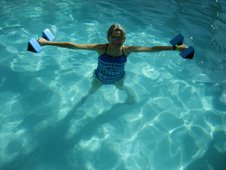You can now pay for individual classes or a series by Google Wallet. Go to www.google.com/wallet
It's easy and fast to reserve your spot in a class today!!!
It's easy and fast to reserve your spot in a class today!!!
JUST ADD WATER!! Take your workout and rehabilitation to the water, the world’s perfect exercise and rehabilitation medium! Highly-effective, low-impact stretching, strengthening, burning of calories, building of muscle, improving movement and flexibility, and having fun. Get Info about water fitness and wellness, nutrition, and general health on my blog. Add your thoughts and experiences. Here's to our Health!
**PROVIDENCE/TARZANA OUTPATIENT THERAPY CENTER SALT-WATER POOL (5359 Balboa Blvd., next to 101 Freeway, Encino)
RSVP TO RESERVE YOUR SPOT!!!!818-383-4400
All classes limited to 6 participants per class! Lots of 1:1 instruction!! FIRST COME, FIRST SERVE!
Open to the community.Private and semi-private sessions.Chair lift is available. Towels, all equipment, locker room and shower provided.AQUATONE (1-hour):(Work your whole body-cardio; strength and flexibility/balance; Adjusted for Arthritis Foundation as needed)
MONDAY: 4:30pmMONDAY/WEDNESDAY: 5:30pmTUESDAY/THURSDAY: 11:30amTHURSDAY: 7pm
SATURDAY: 11:15amFees: $150/8 classes; 1-month expiration$20/drop-in with reservation
NEW YOQUATIX on Sundays!!!45 minutes of restorative land yoga PLUS45 minutes of restorative aqua9:30 am and 10:30 classesHalf-price 1st class--only $20!!Fees: $40/90 minutes; $150/4 classes**BRAEMAR COUNTRY CLUB (Tarzana):
Beautiful outdoor heated pool in
Santa Monica hills.
HIIT The Water! Hi-Intensity!SATURDAY: 9:30am - 10:30amAqua ToneTUESDAY/THURSDAY: 11am - 12pmMembers:Group: 1 class: $20; 8 class package: $150Private: 1 class: $90; 4 class package: $350Semi-Private: 1 class: $45; 4 class package: $170Non-Members:Group: 1 class: $22; 8 class package: $155Private: 1 class: $95; 4 class package: $375Semi-Private: 1 class: $50; 4 class package: $195$29 one-time non-member fee
Free parking, towels, lockers, equipmentCALL 818-383-4400 OR EMAIL aquaflexn@sbcglobal.net
**FOUR SEASONS CENTER FOR HEALTH AND LONGEVITY (Westlake Village)
Private and semi-private sessions are available at this first-class heated indoor pool for members and hotel guests.
**AT-HOME PRIVATE/GROUP SESSIONS:
Want the convenience of a private class at your home? Or, put together your own group, and we'll come to you!
CALL 818-383-4400 or EMAIL at aquaflexn@sbcglobal.net
http://www.linkedin.com/

